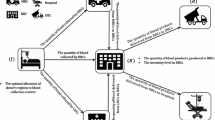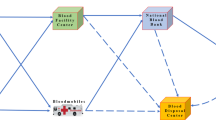Abstract
In a natural disaster such as an earthquake, due to the extensive number of injured, demand for blood units sharply increases in health care centers. Thus, designing an efficient supply chain network for managing blood distribution is one of the major concerns for the healthcare systems under uncertain conditions. This study aims to propose a methodology to minimize the total cost of the blood supply network and total blood shortage. We proposed a new fuzzy multi-period mathematical model using trapezoidal fuzzy numbers by Spherical Fuzzy membership degrees for the blood supply network design. The proposed methodology has considered the possibility of natural disasters in Istanbul (Asian side), the economic and cultural center of Turkey. The proposed model is formulated by fuzzy objective function and fuzzy variables; thus, the final results remained in the fuzzy form. The uncertain parameters are the demand for blood from different blood types in each hospital, the amount of the blood supply in each blood donation facility, the percentage of usable blood, failure rates of the network's components, and network costs. These parameters are represented by trapezoidal fuzzy numbers so that they have membership degrees stated by spherical fuzzy sets. To aggregate decision-makers viewpoints about parameters, spherical fuzzy number algebraic weighted harmonic mean (SFNAWHM) aggregation operator is employed. The relevant network consists of four layers: blood donation areas, blood collection centers, main blood centers, and hospitals. We considered the concept of disruption throughout the supply chain by considering failure rates for all network components. Finally, a sensitivity analysis is performed to validate the proposed fuzzy model and solution methodology.















Similar content being viewed by others
References
Arvan, M., Tavakkoli-Moghaddam, R., & Abdollahi, M. (2015). Designing a bi-objective, multi-product supply chain network for blood supply. Uncertain Supply Chain Management, 3(1), 57–68. https://doi.org/10.5267/j.uscm.2014.8.004
Büyüközkan, G., & Ifi, G. (2012). A novel hybrid MCDM approach based on fuzzy DEMATEL, fuzzy ANP and fuzzy TOPSIS to evaluate green suppliers. Expert Systems with Applications, 39(3), 3000–3011. https://doi.org/10.1016/j.eswa.2011.08.162
Cardoso, S. R., Barbosa-Póvoa, A. P. F. D., & Relvas, S. (2013). Design and planning of supply chains with integration of reverse logistics activities under demand uncertainty. European Journal of Operational Research, 226(3), 436–451. https://doi.org/10.1016/j.ejor.2012.11.035
Cheraghi, S., Hosseini-Motlagh, S.-M., Mohammadreza, & Samani, G. (2016). A Robust Optimization Model for Blood Supply Chain Network Design. International Journal of Industrial Engineering & Production Research, 27(4), 425–444. https://doi.org/10.22068/ijiepr.27.4.425
Cheraghi, S., & Hosseini-Motlagh, S. M. (2020). Responsive and reliable injured-oriented blood supply chain for disaster relief: A real case study. Annals of Operations Research, 291(1–2), 129–167. https://doi.org/10.1007/s10479-018-3050-5
Dean, M. D., & Nair, S. K. (2014). Mass-casualty triage: Distribution of victims to multiple hospitals using the SAVE model. European Journal of Operational Research, 238(1), 363–373. https://doi.org/10.1016/j.ejor.2014.03.028
Derikvand, H., Hajimolana, S. M., Jabarzadeh, A., & Esmaeel, S. (2019). A Fuzzy Stochastic Bi-Objective Model for Blood Provision in Disastrous Time, 12(2), 223–245.
Donyatalab, Y., Farrokhizadeh, E., Seyed Garmroodi, Se. D., & Seyfi Shishavan, S. A. (2019). Harmonic mean aggregation operators in spherical fuzzy environment and their group decision making applications. Journal of Muli.-Valued Logic & Soft Computing, 33(6), 565–592.
Eskandari-Khanghahi, M., Tavakkoli-Moghaddam, R., Taleizadeh, A. A., & Amin, S. H. (2018). Designing and optimizing a sustainable supply chain network for a blood platelet bank under uncertainty. Engineering Applications of Artificial Intelligence, 71, 236–250. https://doi.org/10.1016/j.engappai.2018.03.004
Fahimnia, B., Jabbarzadeh, A., Ghavamifar, A., & Bell, M. (2017). Supply chain design for efficient and effective blood supply in disasters. International Journal of Production Economics, 183, 700–709. https://doi.org/10.1016/j.ijpe.2015.11.007
Farrokhizadeh, E., Seyfi-Shishavan, S. A., & Satoglu, S. I. (2021). Blood supply planning during natural disasters under uncertainty: a novel bi-objective model and an application for red crescent. Annals of Operations Research. https://doi.org/10.1007/s10479-021-03978-5
Fazli-Khalaf, M., Khalilpourazari, S., & Mohammadi, M. (2019). Mixed robust possibilistic flexible chance constraint optimization model for emergency blood supply chain network design. Annals of Operations Research, 283(1–2), 1079–1109. https://doi.org/10.1007/s10479-017-2729-3
Fereiduni, M., & Shahanaghi, K. (2016). A robust optimization model for blood supply chain in emergency situations. International Journal of Industrial Engineering Computations, 7(4), 535–554. https://doi.org/10.5267/j.ijiec.2016.5.002
Ghatreh Samani, M. R., Torabi, S. A., & Hosseini-Motlagh, S. M. (2018). Integrated blood supply chain planning for disaster relief. International Journal of Disaster Risk Reduction, 27, 168–188. https://doi.org/10.1016/j.ijdrr.2017.10.005
Govindan, K., Khodaverdi, R., & Vafadarnikjoo, A. (2015). Intuitionistic fuzzy based DEMATEL method for developing green practices and performances in a green supply chain. Expert Systems with Applications, 42(20), 7207–7220. https://doi.org/10.1016/j.eswa.2015.04.030
Gündoǧdu, F. K., & Kahraman, C. (2019). Spherical fuzzy sets and spherical fuzzy TOPSIS method. Journal of Intelligent and Fuzzy Systems, 36(1), 337–352. https://doi.org/10.3233/JIFS-181401
Gunpinar, S., & Centeno, G. (2015). Stochastic integer programming models for reducing wastages and shortages of blood products at hospitals. Computers and Operations Research, 54, 129–141. https://doi.org/10.1016/j.cor.2014.08.017
Gunpinar, S., & Centeno, G. (2016). An integer programming approach to the bloodmobile routing problem. Transportation Research Part e: Logistics and Transportation Review, 86, 94–115. https://doi.org/10.1016/j.tre.2015.12.005
Habibi-Kouchaksaraei, M., Paydar, M. M., & Asadi-Gangraj, E. (2018). Designing a bi-objective multi-echelon robust blood supply chain in a disaster. Applied Mathematical Modelling, 55, 583–599. https://doi.org/10.1016/j.apm.2017.11.004
Hamdan, B., & Diabat, A. (2019). A two-stage multi-echelon stochastic blood supply chain problem. Computers and Operations Research, 101, 130–143. https://doi.org/10.1016/j.cor.2018.09.001
Hamdan, B., & Diabat, A. (2020). Robust design of blood supply chains under risk of disruptions using Lagrangian relaxation. Transportation Research Part e: Logistics and Transportation Review, 134(January), 101764. https://doi.org/10.1016/j.tre.2019.08.005
Heidari-Fathian, H., & Pasandideh, S. H. R. (2018). Green-blood supply chain network design: Robust optimization, bounded objective function & Lagrangian relaxation. Computers and Industrial Engineering, 122, 95–105. https://doi.org/10.1016/j.cie.2018.05.051
Hosseini-Motlagh, S.-M., Samani, M. R. G., & Homaei, S. (2020). Toward a coordination of inventory and distribution schedules for blood in disasters. Socio-Economic Planning Sciences, 72, 100897. https://doi.org/10.1016/j.seps.2020.100897
Hosseinifard, Z., & Abbasi, B. (2018). The inventory centralization impacts on sustainability of the blood supply chain. Computers and Operations Research, 89, 206–212. https://doi.org/10.1016/j.cor.2016.08.014
Jabbarzadeh, A., Fahimnia, B., & Seuring, S. (2014). Dynamic supply chain network design for the supply of blood in disasters: A robust model with real world application. Transportation Research Part e: Logistics and Transportation Review, 70(1), 225–244. https://doi.org/10.1016/j.tre.2014.06.003
Jacobson, E. U., Argon, N. T., & Ziya, S. (2012). Priority assignment in emergency response. Operations Research, 60(4), 813–832. https://doi.org/10.1287/opre.1120.1075
Kabak, O. (2013). Decision Aid Models for Disaster Management and Emergencies, 7, 74–94. https://doi.org/10.2991/978-94-91216-74-9
Kamali, B., Bish, D., & Glick, R. (2017). Optimal service order for mass-casualty incident response. European Journal of Operational Research, 261(1), 355–367. https://doi.org/10.1016/j.ejor.2017.01.047
Kaveh, A., & Ghobadi, M. (2017). A Multistage Algorithm for Blood Banking Supply Chain Allocation Problem. International Journal of Civil Engineering, 15(1), 103–112. https://doi.org/10.1007/s40999-016-0032-3
Khalilpourazari, S., & Arshadi Khamseh, A. (2017). Bi-objective emergency blood supply chain network design in earthquake considering earthquake magnitude: A comprehensive study with real world application. Annals of Operations Research, 1–39.https://doi.org/10.1007/s10479-017-2588-y
Khalilpourazari, S., Soltanzadeh, S., Weber, G. W., & Roy, S. K. (2019). Designing an efficient blood supply chain network in crisis: neural learning, optimization and case study. Annals of Operations Research. Springer US. https://doi.org/10.1007/s10479-019-03437-2
Kohneh, J. N., Teymoury, E., & Pishvaee, M. S. (2016). Blood products supply chain design considering disaster circumstances (Case study: earthquake disaster in Tehran). Journal of Industrial and Systems Engineering, 9, 51–72. http://www.jise.ir/article_12911.html
Lange, D., Kopp, H., Royer, J. Y., Henry, P., Çakir, Z., Petersen, F., et al. (2019). Interseismic strain build-up on the submarine North Anatolian Fault offshore Istanbul. Nature Communications, 10(1). https://doi.org/10.1038/s41467-019-11016-z
Ma, Z. J., Wang, K. M., & Dai, Y. (2019). An emergency blood allocation approach considering blood group compatibility in disaster relief operations. International Journal of Disaster Risk Science, 10(1), 74–88. https://doi.org/10.1007/s13753-018-0212-7
Mills, A. F., Argon, N. T., & Ziya, S. (2013). Resource-based patient prioritization in mass-casualty incidents. Manufacturing and Service Operations Management, 15(3), 361–377. https://doi.org/10.1287/msom.1120.0426
Mohamadi, A., & Yaghoubi, S. (2017). A bi-objective stochastic model for emergency medical services network design with backup services for disasters under disruptions: An earthquake case study. International Journal of Disaster Risk Reduction, 23(October 2016), 204–217. https://doi.org/10.1016/j.ijdrr.2017.05.003
Oksuz, M. K., & Satoglu, S. I. (2020). A two-stage stochastic model for location planning of temporary medical centers for disaster response. International Journal of Disaster Risk Reduction, 44, 101426. https://doi.org/10.1016/j.ijdrr.2019.101426
Osorio, A. F., Brailsford, S. C., & Smith, H. K. (2015). A structured review of quantitative models in the blood supply chain: A taxonomic framework for decision-making. International Journal of Production Research, 53(24), 7191–7212. https://doi.org/10.1080/00207543.2015.1005766
Osorio, A. F., Brailsford, S. C., Smith, H. K., Forero-Matiz, S. P., & Camacho-Rodríguez, B. A. (2017). Simulation-optimization model for production planning in the blood supply chain. Health Care Management Science, 20(4), 548–564. https://doi.org/10.1007/s10729-016-9370-6
Rahmani, D. (2019). Designing a robust and dynamic network for the emergency blood supply chain with the risk of disruptions. Annals of Operations Research, 283(1–2), 613–641. https://doi.org/10.1007/s10479-018-2960-6
Rais, A., & Vianaa, A. (2011). Operations research in healthcare: A survey. International Transactions in Operational Research, 18(1), 1–31. https://doi.org/10.1111/j.1475-3995.2010.00767.x
Ramezanian, R., & Behboodi, Z. (2017). Blood supply chain network design under uncertainties in supply and demand considering social aspects. Transportation Research Part e: Logistics and Transportation Review, 104, 69–82. https://doi.org/10.1016/j.tre.2017.06.004
Saffar, M. M., Hamed Shakouri, G., & Razmi, J. (2015). A new multi objective optimization model for designing a green supply chain network under uncertainty. International Journal of Industrial Engineering Computations, 6(1), 1–18. https://doi.org/10.5267/j.ijiec.2014.10.001
Salehi, F., Mahootchi, M., & Husseini, S. M. M. (2019). Developing a robust stochastic model for designing a blood supply chain network in a crisis: a possible earthquake in Tehran. Annals of Operations Research, 283(1–2), 679–703. https://doi.org/10.1007/s10479-017-2533-0
Samani, M. R. G., & Hosseini-Motlagh, S. M. (2019). An enhanced procedure for managing blood supply chain under disruptions and uncertainties. Annals of Operations Research, 283(1–2), 1413–1462. https://doi.org/10.1007/s10479-018-2873-4
Talaei, M., Farhang Moghaddam, B., Pishvaee, M. S., Bozorgi-Amiri, A., & Gholamnejad, S. (2016). A robust fuzzy optimization model for carbon-efficient closed-loop supply chain network design problem: A numerical illustration in electronics industry. Journal of Cleaner Production, 113, 662–673. https://doi.org/10.1016/j.jclepro.2015.10.074
Thorani, Y. L. P., & Ravi Shankar, N. (2017). Ranking generalized LR fuzzy numbers using area, mode, spreads and weights. Applied Mathematical Sciences, 11(39), 1943–1953. https://doi.org/10.12988/ams.2017.75183
Tsao, Y. C., Thanh, V. V., Lu, J. C., & Yu, V. (2018). Designing sustainable supply chain networks under uncertain environments: Fuzzy multi-objective programming. Journal of Cleaner Production, 174, 1550–1565. https://doi.org/10.1016/j.jclepro.2017.10.272
Vahdani, B., Tavakkoli-Moghaddam, R., Jolai, F., & Baboli, A. (2013). Reliable design of a closed loop supply chain network under uncertainty: An interval fuzzy possibilistic chance-constrained model. Engineering Optimization, 45(6), 745–765. https://doi.org/10.1080/0305215X.2012.704029
Wang, H. F., & Hsu, H. W. (2012). A possibilistic approach to the modeling and resolution of uncertain closed-loop logistics. Fuzzy Optimization and Decision Making, 11(2), 177–208. https://doi.org/10.1007/s10700-012-9120-2
You, F., & Wang, B. (2011). Life cycle optimization of biomass-to-liquid supply chains with distributed-centralized processing networks. Industrial and Engineering Chemistry Research, 50(17), 10102–10127. https://doi.org/10.1021/ie200850t
Zadeh, L. A. (1965). Fuzzy sets. Information and Control, 8(3), 338–353. https://doi.org/10.1016/S0019-9958(65)90241-X
Zahiri, B., & Pishvaee, M. S. (2017). Blood supply chain network design considering blood group compatibility under uncertainty. International Journal of Production Research, 55(7), 2013–2033. https://doi.org/10.1080/00207543.2016.1262563
Zhang, Z. H., & Jiang, H. (2014). A robust counterpart approach to the bi-objective emergency medical service design problem. Applied Mathematical Modelling, 38(3), 1033–1040. https://doi.org/10.1016/j.apm.2013.07.028
Zimmermann, H.-J. (1978). Fuzzy programming and linear programming with several objective functions. Fuzzy Sets and Systems, 1(1), 45–55. https://doi.org/10.1016/0165-0114(78)90031-3
Author information
Authors and Affiliations
Corresponding author
Additional information
Publisher's Note
Springer Nature remains neutral with regard to jurisdictional claims in published maps and institutional affiliations.
Appendix A. Data used in the model
Appendix A. Data used in the model
See Tables 11, 12, 13, 14, 15, 16, 17, 18, 19, 20, 21, 22, 23, 24, 25 and 26.
Rights and permissions
About this article
Cite this article
Seyfi-Shishavan, S.A., Donyatalab, Y., Farrokhizadeh, E. et al. A fuzzy optimization model for designing an efficient blood supply chain network under uncertainty and disruption. Ann Oper Res 331, 447–501 (2023). https://doi.org/10.1007/s10479-021-04123-y
Accepted:
Published:
Issue Date:
DOI: https://doi.org/10.1007/s10479-021-04123-y




